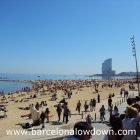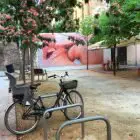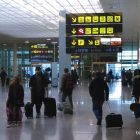It’s no secret that choosing the right hotel or apartment can make or break a holiday, and deciding where to stay is possibly the most important decision you’ll make when planning a trip to Barcelona.
In this post, I’ve pooled together the knowledge gained from more than twenty years of living in the city to help you decide which neighbourhood is best and find a hotel that fits your needs and expectations.
Where is the best area to stay in Barcelona?
If this is your first time in Barcelona, I recommend staying near Plaça de Catalunya. This very central location is close to many of Barcelona’s main attractions and is a transport hub with easy connections to the airport and other parts of the city.
Plaça de Catalunya is located at the intersection between the Gothic Quarter, L’Eixample and El Raval neighbourhoods. Many of Barcelona’s best-known sights are within walking distance, and there are a wide variety of restaurants, bars and nightlife options nearby.
There are plenty of hotels in this area including the highly popular Olivia Plaza Hotel which overlooks the plaza or the family-friendly Hotel Regina which has several family rooms that sleep three or four people.
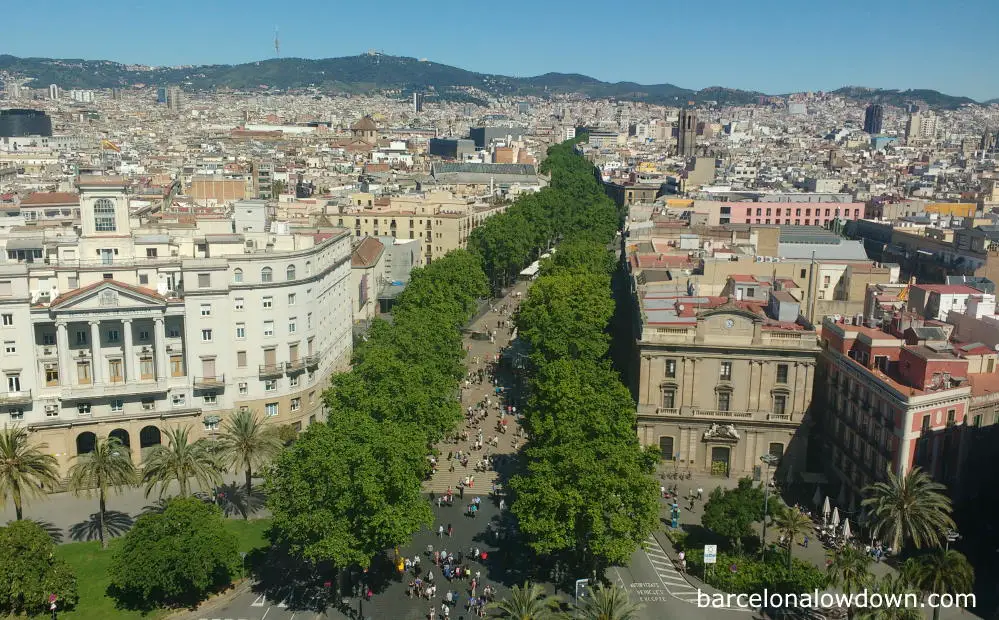
Having said that, Barcelona is a relatively compact city and has an excellent public transport system and many visitors prefer to stay in other areas of the city. Hotels in the less central neighbourhoods are often slightly cheaper and offer better value for money.
In this article, we take a look at Barcelona’s most popular neighbourhoods and weigh up the pros and cons of staying in each of them.
Barcelona Neighbourhood Guide
1. Gothic Quarter
The Gothic Quarter is the oldest part of the city and, even today, is still the living heart of Barcelona. A maze of narrow streets and alleyways connecting romantic plazas surrounded by historic buildings, it’s a great place to stay if you want to have everything close to hand.
Not only is this the area where many of the city’s best-known attractions are located, but there are also lots of places to eat and drink as well as plenty of nightlife to choose from. If you will only be in Barcelona for two or three nights, then the Gothic Quarter is an ideal area to stay within walking distance of most of the top sights.
Due to its popularity, the Gothic Quarter has a wide range of hotels for all budgets, from luxury five-star accommodation to budget hotels and backpacker hostels. There are also plenty of bars and restaurants that cater to tourists, many of which are located on or near the famous La Rambla.
The only downside to staying in the Gothic Quarter is that, depending on where you stay, it can be a bit noisy. Many of the narrow, pedestrianised streets are a hive of activity both day and night. If you are a light sleeper and want to stay in the old town, you should either choose a hotel with good soundproofing or stay in the area between Plaça de Catalunya and Barcelona Cathedral which tends to be a bit quieter.
Main attractions in the Gothic Quarter
- Barcelona Cathedral
- La Rambla
- Plaça Reial
- Barcelona Town Hall & Plaça Sant Jaume
- Bishop’s Bridge
- El Call (Jewish Quarter)
- MUHBA (Barcelona history museum)
- Temple of Augustus
- Port Vell harbour
- Plaça de Sant Josep Oriol
- Plaça de Sant Felip Neri
- Basilica of La Mercè
- The Columbus Monument
If you arrive by taxi from the airport, some of the narrowest streets in the Gothic Quarter are closed to traffic, and the driver may have to drop you a few metres from your hotel.
Recommended hotels in the Gothic Quarter
- H10 Madison (4 star hotel)
- Hotel Barcelona Catedral (4 star hotel)
- Hotel El Call (Budget hotel)
- Hostal Fina (Budget hotel)
2. L’Eixample neighbourhood
The Eixample was built during the nineteenth and twentieth centuries after the old city centre’s medieval walls were torn down. The area is characterised by wide streets and tree-lined avenues flanked by elegant five to seven-story buildings.
The Eixample is where most of Barcelona’s famous Modernista buildings are located, including Casa Batlló, La Pedrera, the Sant Pau Art Nouveau Site, and La Sagrada Familia. This is also where many of the city’s most upmarket shops, restaurants and hotels are located.
Strictly speaking, l’Eixample is a district of Barcelona that is divided into ten neighbourhoods, including Eixample left, Eixample Right, Sagrada Familia, Fort Peinc and Sant Antoni.
When choosing a hotel in l’Eixample, as with most areas outside the Gothic Quarter, I recommend you base your choice on what the hotel offers and proximity to a metro station rather than the exact location.
Main attractions in the Eixample neighbourhood
- Sagrada Familia
- Casa Batlló
- La Pedrera
- Casa Amatller
- Passeig de Gràcia
- Casa de les Puntxes
- Sant Pau Art Nouveau Site
- La Monumental bullring
- Las Arenas shopping centre
- Joan Miró Park
Recommended hotels in the Eixample neighbourhood
- Praktik Essens (3 star hotel)
- Hotel Jazz (3 star hotel)
- Ibis Barcelona Centro (Budget hotel)
- Sant Jordi Hostels Rock Palace (Backpacker hostel)
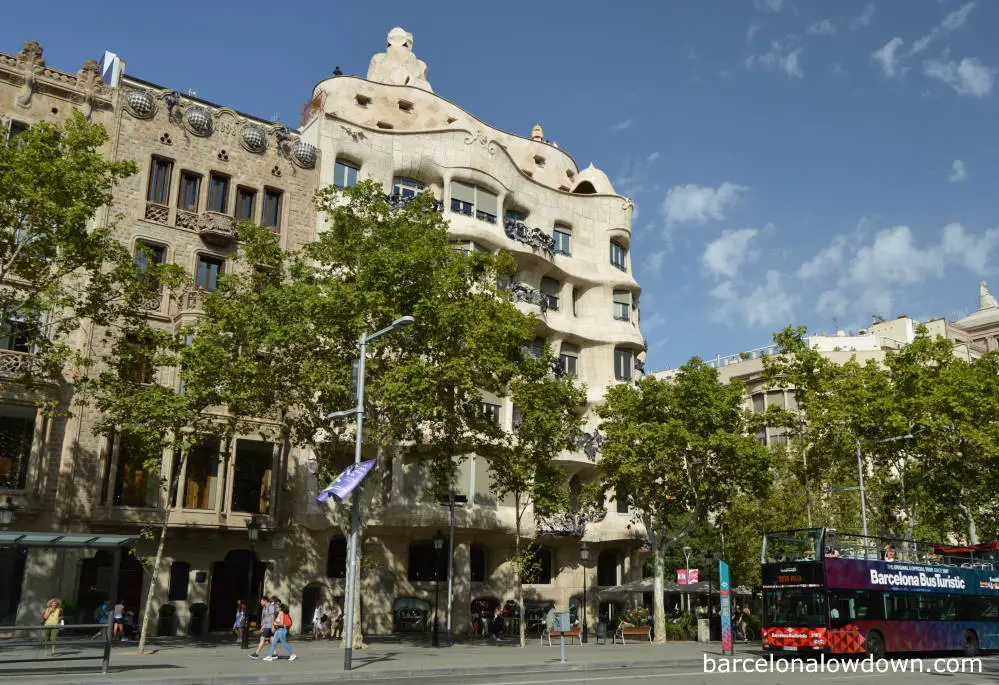
3. El Raval neighbourhood
South of the Gothic Quarter, the Raval neighbourhood has always had a rather dodgy reputation and used to be the city’s main red-light district. Although some areas have been cleaned up and gentrified in recent years, other parts are still rather run down and a bit seedy late at night.
Having said that, El Raval is a lively, colourful neighbourhood that attracts students and young people. Streets like Joaquin Costa, La Rambla del Raval and Pintor Fortuny are good areas for going out at night with a wide range of lively bars and restaurants to choose from.
The Raval is also home to the world-famous La Boqueria food market and the MACBA and CCCB art museums.
If you decide to stay in El Raval, I recommend looking for a hotel in the area between Carrer dels Angels, Carrer del Carme, La Rambla and Carrer Pelai.
Main Attractions in the Raval neighbourhood
- La Boqueria food market
- El Liceu opera house
- MACBA modern art museum
- Barcelona Maritime Museum
- CCCB art museum
- Palau Güell
- The Church of Sant Pau del Camp
- Botero’s cat sculpture and La Rambla del Raval
Recommended hotels in the Raval neighbourhood
- Hotel Lleo (3 star hotel)
- Eco Boutique Hostal Grau (Boutique hotel)
- Hostal la Palmera (Budget hotel)
- Boutique Hotel Casa Volver (Boutique hotel)
4. El Born; Sant Pere, Santa Caterina and La Ribera neighbourhoods
Strictly speaking, El Born refers to a small area that runs from the Santa Maria del Mar Church to El Mercat del Born. However, most people use the term El Born to refer to the neighbourhoods of Sant Pere, Santa Catarina and La Ribera.
Part of the old city, but less touristy than the Gothic Quarter, El Born is an attractive neighbourhood of old buildings, narrow streets and charming plazas where you can sit and enjoy a drink while watching the world go by.
The Born is an excellent area to stay if you are looking for a lively, central location with a good variety of places to eat and drink but without the Gothic Quarter’s tourist crowds.
Traditionally an area of artisans and tradespeople, the neighbourhood is dotted with picturesque plazas and tiny boutique shops selling handmade clothing and art. It is also within easy walking distance of the beach.
Main Attractions in the Born neighbourhood
- The Picasso Museum
- Palau de la Musica
- Saint Catherines Market
- Santa Maria del Mar Church
- Ciutadella Park
- Barcelona Chocolate Museum
- El Born Cultural Centre
Recommended hotels in El Born Area
- H10 Port Vell (4 star hotel)
- Hotel K&K Picasso (Boutique hotel)
- Hostal Orleans (Budget hotel)
- Pension Ciudadela (Budget hotel)

5. Barceloneta neighbourhood
The Barceloneta neighbourhood is the old fishermen’s district that was built during the eighteenth century. Located between the beach and the Port Vell harbour, it’s a traditional working-class neighbourhood reminiscent of the old quarter of other Mediterranean cities.
The main reason for staying in La Barceloneta is its proximity to the beach since there aren’t many attractions in the area. The neighbourhood’s other draws are many seafood restaurants and small tapas bars.
There are very few hotels in the Barceloneta neighbourhood and most people who choose to stay here rent an apartment. When renting an apartment, you should ensure that it is correctly licensed by the local authorities and bear in mind that some of the apartments are very small (35m square isn’t uncommon in this part of the city), and many of the older buildings don’t have lifts.
Main attractions in the Barceloneta neighbourhood
- La Barceloneta beach & waterfront
- Port Vell harbour
- The port cable car
- Museum of the history of Catalunya
Recommended hotels in the Barceloneta neighbourhood
- Hotel 54 (3 star hotel)
- H10 Port Vell (4 star hotel)
6. Gràcia neighbourhood
Once a separate town that Barcelona annexed during the early part of the twentieth century. Gràcia still maintains its own village-like identity. Life here revolves around the many picturesque plazas where you can sit, drink a coffee or a beer and watch the world go by.
The neighbourhood attracts ex-pats and artists who are drawn to its independent and alternative nature. This bohemian population is reflected in the number of small boutique shops selling handmade items and organic or recycled products.
A good choice if you want to try and avoid the tourist crowds and experience Barcelona like a local, the only big-name attraction in Gràcia is Antoni Gaudí’s Park Güell.
The downside of staying in Gràcia is that it’s not very central and you’ll have to use public transport quite a lot when visiting other parts of the city. Having said that, Barcelona’s public transport system is excellent and inexpensive.
Main attractions in the Gràcia neighbourhood
- Park Güell
- Casa Vicens
- Gaudi Experience
- Plaça del Sol & Plaça de la Vila de Gràcia (squares)
- Mercat de la Llibertat (market)
Recommended hotels in the Gràcia neighbourhood
- Hotel la Casa del Sol (3 star hotel)
- Gràcia Garden Boutique Hotel (2 star hotel)
- Hotel Bestprice Gràcia (Budget hotel)
- Generator Barcelona (Backpacker hostel)
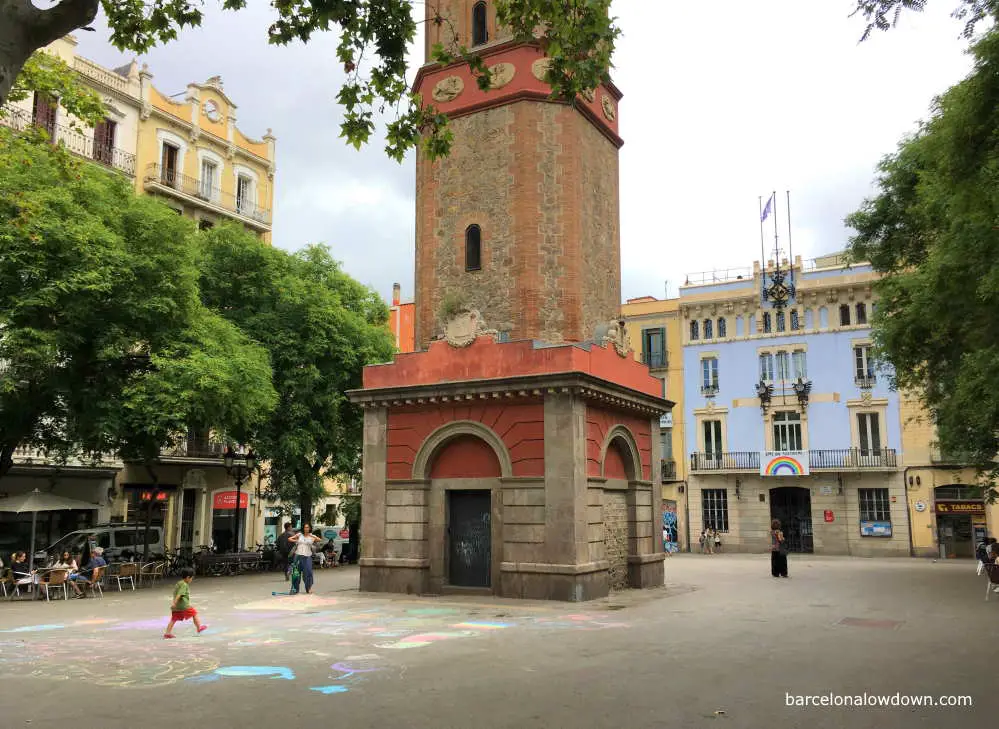
7. Poble Sec & Sant Antoni neighbourhoods
In recent years the Poble Sec and Sant Antoni neighbourhoods have earned a well-deserved reputation for being the best area in Barcelona for foodies.
Carrer Blai, Carrer del Parlament and Ronda de Sant Antoni are home to a host of tapas bars that are as good as any you’ll find anywhere in the city. You’ll also find a selection of ethnic and vegetarian restaurants in this area, not to mention Tickets, the famous tapas bar owned by Ferran and Albert Adrìa.
Apart from the food, the Poble Sec and Sant Antoni Neighbourhoods are an excellent choice for budget-conscious travellers.
The slightly less central location means that hotels in this area offer better value for money than those in Barcelona city centre. Having said that, Poble Sec is only four stops on the metro from the city centre, and you could easily walk to the centre of town in less than twenty minutes.
Main attractions in the Poble Sec & Sant Antoni neighbourhoods
- Mercat de Sant Antoni (market)
- Jardins de les tres Xemeneies (graffiti park)
- Shelter 307 (air raid shelter)
Recommended hotels in the Poble Sec & Sant Antoni neighbourhoods
- Hotel Barcelona Apolo (3 star hotel)
- Hotel Brummell (4 star hotel)
- Hotel Paral.lel (Budget hotel)
- Mambo Tango Youth Hostel (Backpacker hostel)
8. Poblenou neighbourhood
Once an industrial area full of factories and mills, in recent years, Poblenou has reinvented itself as one of Barcelona’s most up and coming neighbourhoods.
Investment in the area started during the nineteen eighties when the Olympic Village and Marina were built. The waterfront was cleaned up, and tons of sand were shipped in from the Sahara to create several kilometres of sandy beaches.
In more recent years, the old factory buildings have been torn down and replaced by modern start-ups, and tech companies in an area called the 22@ technological district. Several international hotel chains have also built large hotels in the area that cater to both business travellers and families or couples looking for a modern hotel near the beach and well connected to the city centre.
Although Poblenou is a long walk from the city centre, it’s easy to get into town by metro or bus in around twenty minutes. If you want to eat near to your hotel, there are plenty of restaurants and bars to choose from on the charming Rambla del Poblenou.
Main attractions in the Poblenou neighbourhood
- La Rambla del Poblenou (boulevard)
- The Agbar Tower
- The Encants fleamarket
- DHUB Barcelona (design museum)
- Barcelona’s Beaches
- The Olympic Marina
- Poblenou Cemetery
- Museu Blau (natural history museum)
Recommended hotels in the Poblenou neighbourhood
- Four Points by Sheraton (3 star hotel)
- Acta Voraport (3 star hotel)
- Hostal Pobenou B&B (Bed and breakfast)
- Ibis Barcelona Plaza Glòries 22@ (Budget hotel)
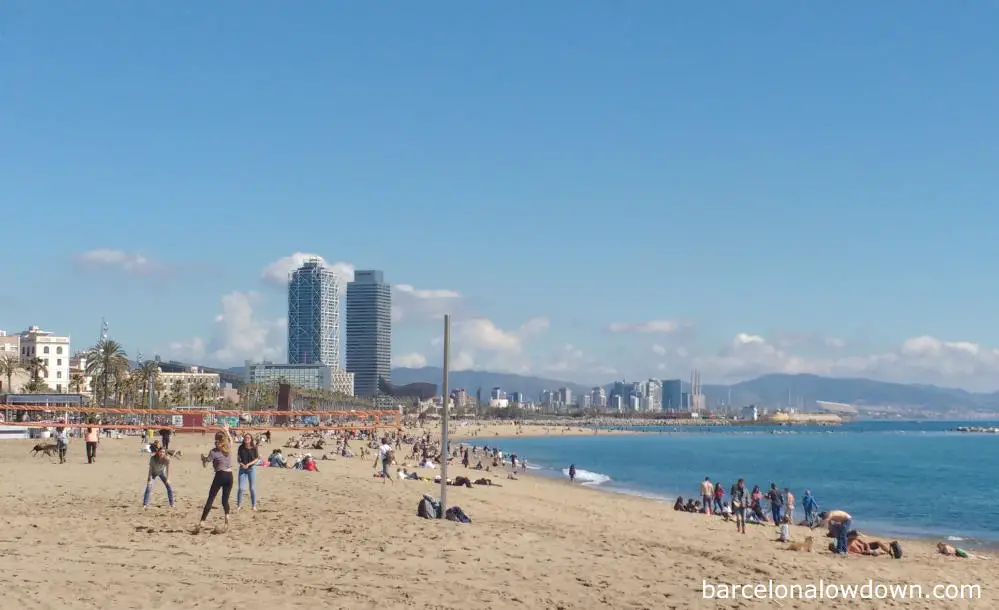
9. Sants-Montjuïc neighbourhood
Sants Montjuïc is the largest district of Barcelona. It includes the residential neighbourhoods of Sants, Hostafrancs and Poble Sec, as well as the mountain of Montjuïc and the Zona Franca Industrial area.
With a few notable exceptions, most of the area’s hotels are in Sants, Hostafrancs and Poble Sec. Hostafrancs and Sants are ideal neighbourhoods to stay in if you are attending one of the many trade fairs that take place in the Fira conference centres located at Plaça d’Espanya.
Many of the hotels in the area cater to business travellers and offer accommodation aimed at this type of customer; comfortable modern rooms with good Wi-Fi, a desk in the room and buffet breakfast.
The main attractions in the area are located on Montjuïc, which can be accessed by bus from Plaça d’Espanya, by cable car from the Barceloneta or by funicular railway from Paral·lel.
Despite the lack of tourist attractions, the Sants neighbourhood is a transport hub that includes Barcelona’s main train station and is about 15 minutes from the city centre by metro. The number 46 bus from Barcelona Airport plus the Aerobus fast shuttle bus both stop at Plaça d’Espanya.
The Camp Nou football stadium is also nearby. If you visit Barcelona to see a football match, a concert at the Palau de Sant Jordi, or take part in a sporting event such as the Barcelona Marathon, Sants would be a convenient area to stay.
Main attractions in the Sants Montjuïc district
- Plaça d’Espanya
- The Magic Fountain
- Montjuïc castle
- Palau Nacional and the MNAC museum
- Poble Espanyol (Spanish village)
- La Caixa Forum (art museum)
- Montjuïc cable cars
- Olympic stadium
- Miró foundation
- Montjuïc parks & botanical gardens
Recommended Hotels in the Sants Montjuïc neighbourhood
- Barceló Sants
- Catalonia Barcelona Plaza
- Ayre Hotel Gran Vía
- Hostel One Sants (Backpackers hostel)
Other Barcelona Neighbourhoods
So far, we’ve focussed on the most convenient neighbourhoods to stay in Barcelona when visiting the city. There are plenty of hotels in other areas of the city but, depending on where you stay, you might end up having to take a long bus ride or metro journey to get to and from the city centre.
If you don’t mind the inconvenience, then you may be able to find a bargain, but you should try and work out exactly how long it will take to get to and from the city centre before making a reservation.
If you’re unsure, feel free to leave a comment below with the hotel’s name and address, and I’ll let you know what I think of the location.
Where to stay in Barcelona FAQs
Where is the best area to stay in Barcelona for first-timers?
If this is your first time in Barcelona, I recommend you stay near Plaça Catalunya. This very central location is close to many of Barcelona’s main attractions and is a transport hub with easy connections to the airport and other parts of the city.
Where is the best area to stay in Barcelona on a budget?
Generally speaking, hotels located outside the main tourist areas offer better value for money. The Poble Sec and Sant Antoni neighbourhoods are a good choice for budget travellers due to their proximity to the city centre and generally lower prices. Both neighbourhoods also offer a wide range of places to eat and drink at all price points.

Where is the best area to stay in Barcelona for families?
When visiting Barcelona with kids, I recommend staying in the Gothic Quarter or the Eixample neighbourhoods, in the area nearest to Plaça de Catalunya. By staying in this very central location you’ll minimize time spent travelling to and from the city’s main attractions.
The only exception would be if you are travelling with infants or small children in which case you might prefer to stay in a quieter area such as Gràcia or Poblenou.
Check out our guide to visiting Barcelona with kids here >>
Where is the best area to stay in Barcelona for nightlife?
Barcelona’s largest and best-known nightclubs are located in the Poblenou neighbourhood. Pacha, Shôko and Opium are all located on the beach next to the Olympic Marina. Razzmatazz, a massive club with five dance floors and three live music venues, is located near the Bogatell and Llacuna metros stations.
Having said that, Barcelona’s nightlife isn’t confined to one area, and there are plenty of nightclubs, theatres and music venues in other parts of the city. Areas such as the Gothic Quarter, El Born Sant Antoni and Poble Sec and the more central areas of l’Eixample have plenty of restaurants and tapas bars to choose from.
Where is the best place to stay in Barcelona before a cruise?
The nearest hotel to Barcelona’s cruise port is the Eurostars Grand Marina Hotel, an excellent five-star hotel located right at the harbour. Alternatively, there are plenty of other hotels located along La Rambla or Av. Parallel, which is also a short taxi ride from the cruise terminals.
Which hotels are located nearest to the beach in Barcelona?
There are four hotels located right on the beach in Barcelona; three luxury five-star hotels and one backpacker’s hostel:
- W Hotel Barcelona (5 star hotel)
- Safestay Barcelona Sea (Backpackers hostel)
- Pullman Barcelona Skipper (5 star hotel)
- Hotel Arts (5 star hotel)
If you want to stay near the beach but don’t need the luxury of a sea view, look for a hotel in the Barceloneta or Poblenou neighbourhoods. There are also several hotels with waterfront views located next to the Port Vell marina.
Conclusion
If this is your first visit to Barcelona or you’re only visiting for two or three days, I recommend that you look for a hotel near Plaça de Catalunya. This very central location is within walking distance of most of Barcelona’s main sights, and there are a wide variety of places to eat and drink nearby.
Plaça de Catalunya is also a transport hub with frequent metro, bus and trains to other parts of the city and fast shuttle buses to and from the airport.
If you are a light sleeper or want to experience the city like a local. In that case, you might want to stay in areas such as Poblenou or Gràcia, which, even though they are less central, offer easy access to the city centre by public transport.
For budget travellers, accommodation in Poble Sec and Sant Antoni is generally better value than the Gothic Quarter and is still within walking distance or a short metro ride from most sights.
At the end of the day, Barcelona is a compact city with an excellent public transport system. If you find a hotel that you like the look of and which gets good reviews online, then you shouldn’t obsess too much about staying in a specific location. All the neighbourhoods mentioned in this post are good areas to stay in.
As always, if you have any questions, leave a comment below, and I’ll get back to you as soon as I can.
Disclaimer
If you book a hotel after clicking through one of the links on this page, I will receive a commission at no extra cost to you.
As a longtime Barcelona resident, I haven’t stayed at any of the hotels mentioned in this article. I’ve selected a mixture of mid-range and budget hotels based on their location and the reviews they receive online, plus comments that I get from readers of this blog.

